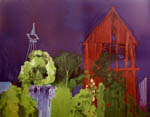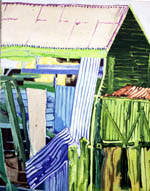
The Australian Paintings
The Happy Country
The coastal landscape of Australia is mostly timber and it is used extensively in both domestic and commercial architecture to good effect. The extensive rôle timber and timber architecture plays in the Australian landscape has influenced the works of earlier Australian artists like Nicolas Chevalier and Hans Heysen. It has imposed the particular linear style that is noticeable in Matthew’s Australian landscapes.
In the countryside beyond Melbourne, timber architecture is to be seen in abundance. It is used for farms and outbuildings, dividing paddocks with weather-worn posts and railings and dotted over the landscape in the form of curiously shaped dead trees and grey tree stumps. Also unusual are the buildings roofed in corrugated iron. In Australia it is used with great imagination and elaborate architectural permutations in the roofing of rural houses.
Painting the Australian landscape Matthew was conscious of seeing for the first time, a completely fresh subject: he acquired a new vocabulary, seeing what many possibilities could be wrought from rusting warped sheets of corrugated iron roofs, twisted grey timbers of abandoned farm buildings and the many kinds and varied forms and colours of Eucalyptus trees
Deep greens combine with light acid tones and yellows used in the Australian paintings show the use of scumbling, glazing and overpainting. These works of art owe their deep tones and soft matt appearance to the absorbent and dark brown canvas priming the artist adopted while working in Australia. What principally attracts the viewer is the abundance and variety of the many kinds of Eucalyptus trees and mangrove swamps. The venomous local wildlife, bush flies, poisonous snakes and vicious soldier ants made creating these paintings out of doors especially in the jungles of north west Queensland both difficult and hazardous.

The Bush at the Ancient Gold Fields of Creswick, Australia
The bush at Creswick is the largest of the Ballarat series of paintings that Matthew Moss completed for an exhibition in Sydney at the Bloomfield gallery during the years he stayed in Australia. in the 1850's Creswick township was one of the first places where gold was discovered in Australia and where more than 25,000 gold miners gained and lost fortunes. Nearby, in the town of Ballarat was the gold-mining exchange founded in 1887, the principal centre for buying and selling shares of mining companies, and financing the minefields. Matthew discovered the gold exchange soon after he arrived in Australia, when by then it had been abandoned for decades but, happily, still retained many of its beautiful original Victorian features including its superb original glass and carved timber vaulted roof. The artist decided to restore it to its original state and for many years used it as his studio and where it became the centre for conservation for the many art museums in the surrounding state of Victoria. In its heyday intensive gold mining upended the whole Creswick area. Now regrown bush and generations of wildlife have obliterated the ravages of mining - no signs remain of the boom and bust of the gold mining that was carried on here.
The original painting was a small acrylic sketch executed onto canvas board and that the artist painted in the bush. The work was of horizontal dimensions and thus accommodated a more widely spaced group of trees. In the final painting these were reduced to the half dozen or so now visible. In somewhat the same manner as "The pot plant" the artist reduced the trees' foliage to graphic elements. Against a very light background in yellow, a deeper mixture of cadmium yellow and yellow ochre has been used to create a mass of meshed and woven tangled forms and lines streaming down from the top of the canvas to meet the tree trunks to assume more conventional forms. These are painted in a mixture of light yellows, orange, olive greens and white with each tree limited to one or two colours giving the impression of a two colour negative.
In the lower half of the canvas the background is brushed in with greens and pinks. The area to the right echoes the theme of the trees' foliage with the same colour carried forward to the left foreground by the dead tree in green. The predominant theme of the canvas is of continual vertical movement relieved by the diagonal of the two fallen tree trunks in white and cadmium yellow in the lower section. The feeling of softness and gracefulness the painting evokes is partly the result of the painting having been executed on a semi‑absorbent white primed canvas and partly the result of using colours in a high register that evoke the qualities of a pastel.
 Large image, details and buy
Large image, details and buy

Abandoned Yellow Timber Hay Barn in Gippsland
The painting shows an abandoned timber hay barn in a dairy farming area of the state of Victoria, Australia. Against a blue sky, the heavy timber roof of the building is supported by warping tree trunks, in imminent danger of collapse. They are backed by segments of corrugated iron which is also used in the holed and rusted water tank to the left. The ceruleum and cobalt blue timber stall in the foreground once held the cattle waiting to be milked.
The painting was begun on a Belgian linen canvas with a white acrylic priming using acrylic based pigments. The artist's plan was to conceive of the painting as a series of vertical lines represented by the pillars supporting the roof and the lines of the posts forming the uprights of the stalls. Sufficient movement and interest for the eye is provided by the irregular nature of the sagging timbers and the textures of the upper section.
The acrylic technique provides clean graphic design in the lower foreground relieved by the violet tints of the shed on the left. These give way in the middle portion, to light-green timber posts lightly painted in oils against the corrugated iron rear walls which are themselves in acrylic. A number of the support posts in the upper section are silhouetted in strong green.Extensive use of impasto and the wet-into-wet techniques of oil painting is visible in the upper section. The cross beams are indicated by gouging out the background colour with a loaded brush and using a number of transparent yellows and yellow orange.
This painting formed part of a series of three works carried out in the open in Heyfield - an old hardwood timber and cattle town in the goldfields belt of the state of Victoria - including one canvas larger and one smaller than the present. The yellow barn with its emphasis on primary colours, fight blues, greens and yellows, is the more formally abstract of the three. The textured nature of the upper section contrasts with the blueprint‑like or diagrammatic style of the remainder (particularly the complex play of vertical and horizontal posts in the lower left section painted in a mixture of acrylic and oil based cobalt blues) and gives it a sense of constant movement.
 Large image, details and buy
Large image, details and buy
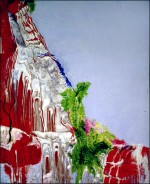
Fern Tree Gully Waterfall, Australian Alps
Fern Tree gully waterfall was completed in Ballarat, Australia. It formed part of a Sydney exhibition at the Bloomfield gallery. It originated as a felt pen drawing dated executed in Raglan in the state of Victoria. The drawing shows the falling waters, and Moss' serendipity in capturing their mass and the ever changing patterns and shapes which they assume. In watercolours done previously in Agadir in Morocco the artist had depicted the movement of the waves in a more severely abstract form reducing them to coloured patterns; here the waterfall is treated in a more calligraphic manner.
In the drawing's transition to canvas a Belgian linen was primed in a white chalk darkened by the addition of acrylic burnt umber. The unevenly woven support was allowed to retain its roughness by the application of the colours as washes which tend to sink into the surface. Part of the painting's undercoat was laid over with an application of fight blue wash, reinforced in the background sky, giving a somewhat mauve appearance to the lower right underpainting. A number of alterations which the work underwent during the course of construction, including a timber shed in the lower right-hand section, can be seen under radiographic examination. The painting forms part of a series with the another oeuvre the "Wannon falls" *also of a relatively large format painted on a dark priming. The large Wannon falls was executed to a greater extent in oils to exploit the features inherent in glazes and transparent colours. However, both the paintings began as naturalistic sketches which Moss then modified.
In the Ferntree gully waterfall this is most clearly seen in the use of primary colours; the dramatic cadmium reds, touches of cobalt to silhouette the waterfall, and mauves and primary greens, take the work one remove from naturalism. The orange segment in the upper part of the canvas acts as a background foil to the four white brushstrokes indicating the emergence of a stream of water. The lightly sketched-in dead tree trunk on the left is echoed in the luxuriant mass of green cabbage ferns which emerge from a gap in the rockface, offering relief to the eye from the intense reds and blues which dominate the canvas. The white calligraphic brushstrokes of the failing waters in the centre of the rock formation continue as rivulets and streams breaking over the scarlet rocks to the left and dribbling and escaping as vapours in the pools in the lower right giving rise to what in Ireland would be known as a busy canvas.
*http://www.artmontecarlo.com/image_details.php?painting_id=449
 Large image, details and buy
Large image, details and buy

Mount Buffalo waterfall in the Australian Alps
The Australian Alps in winter display an overall greyness because of the massive rocks, heavy mists and snow in marked contrast to the colours chosen by the artist Matthew Moss' Mount Buffalo waterfall. The canvas is executed in variations of green ranging from light cadmium greens mixed with titanium white to zinc yellow and fight cadmium yellow through to deeper tones of the same colours in the middle passages. The massive boulders from which the waterfall cascades are painted in a fight, rococo manner with the only other colour in the canvas, the grey-blue sky, providing the foil. The solitary rock on the right is executed with some impasto provided by the addition of alumina hydrate zeolite pigment.
The artist used acrylic colours for the flat tones in the very light area at the top of the canvas. In addition, Matthew used oil based pigments for the modelling of the contours of the rocks and waterfall. The painting's support is a fine grained Belgian linen primed with a white gesso. Over this and extending to the lower levels of the footbridge an undercoat of fight blue in acrylic has been added, giving a cool appearance to this part of the canvas. In the lower section an undercoat of a dark lead tone in acrylic has been added. Here, deeper tones of oxide of chromium and olive green emphasise the darkness of the priming, creating a dark cavern spanned by the footbridge. The two bridge supports display a climbing vine while the seething waters of the river are executed in variations of olive green and white, in a graphic linear manner. The painting was begun in August 1980 and based on a series of pencil sketches, although the main composition was from a drawing of a footbridge crossing a rock strewn torrent which was fairly complete in itself. It was as a consequence only necessary to incorporate a second drawing, a massive precipice, to complete the composition.
By selecting a non-Ânaturalistic range of colours, the artist distanced himself from any tendency to naturalism. Although the subject is recognisable as a bridge over a waterfall, it can be seen in the manner in which he has sketched the bridge, the delineation of the rocks and the formal arrangement of the water's movement, that the artist has chosen the subject matter as an exercise in calligraphy. He has extended the range of tones from a limited selection of colours and established the form of the details in the most economical manner. Two years after the painting was completed it was reworked but to a minor degree.
 Large image, details and buy
Large image, details and buy

Australia's mysterious Hanging Rock
Hanging Rock° is seen here as a solitary mass set off against a blue sky. The individual boulders and rocks which make up the sacred site are boldly drawn in by Matthew Moss in straight simple brushstrokes of orange and red and are hatched in to form masses indicating shadows cast by former volcano . They are indicated by flat washes of fight cobalt violet highlighted mostly towards the upper centre with white. Elsewhere emphasis is given to the rocks by the use of a deeper cobalt violet brushstroke. A very small amount of foliage is indicated with fight touches of green visible in the centre and top of the painting.
In this canvas the artist's usual preoccupation with high tones is reversed. Instead, the canvas is largely painted in acrylic while the deeper shadows and the outlines of the rock formations are indicated in an oil based orange. The canvas of Belgian linen has been primed in white over which has been washed a fight coat of raw siena. This is allowed to come through and add its tone to the overall effect in the area of the rocks.
This painting formed part of a series of large canvases which were executed in Ballarat, an ancient gold mining town, and shown in his subsequent Sydney exhibition in the same year. The painting's second showing in Australia was at the artist's Melbourne exhibition. As with the Fern Tree gully waterfall°° the painting is based on an undated drawing, done on the site of the sacred red rock. It is noticeable that there are no trees or shrubs on the rock itself while the surrounding country is densely grown. This growth, which occupies the lower third of the pencil drawing disappears completely in the painting, apart from the occasional shrubs in the crevices of the boulders. While the drawing is of some complexity, it is interpreted as a painting with much simpler and broader lines.
°Hanging Rock, 70 km from Melbourne in Australia, is a distinctive and sombre rock mass. sacred to the Wurundjeri nation. The Rock inspired Joan Lindsay's 1967 novel Picnic at Hanging Rock. In 1975 an eponymous film was produced describing the mysterious disappearance of schoolgirls on a visit to the sacred site.
°°http://www.artmontecarlo.com/image_details.php?painting_id=438
 Large image, details and buy
Large image, details and buy

The Checkerboard Watertower on a Gippsland Farm
The painting is an accurate description of a watertower in an area of the Victoria state in Australia. Most of these cattle farms relied in the past on rain water storage in galvanized iron cisterns during frequent periods of drought. It would be, often, the only source of potable water The graphite drawing on which Matthew Moss based the painting shows that the haybarn on the right had, by then, assumed the architectural inclinations of the tower of Pisa. One can see that the entire structure, including the two lean-to sheds, is rigorously composed of corrugated iron, an ante-litteram Frank Gehry. The beauty of these farm buildings was the skill with which the builders integrated hardwood timber elements into the overall iron structure. In 'The checkerboard watertower on a Gippsland Farm' Matthew has brought into relief the timber elements by using red and yellow ochre pigments in place of the cobalt blue of the landscape's dominating colour. The green oxide colour used to add contrast is the only other colour that features in the canvas. The remaining elements, the sky, timber footpath and railing and gate use the cobalt blue to create an effect of 'false colour' - mostly encountered in infrared colour photography - to strip out any too naturalistic artistic elements.
 Large image, details and buy
Large image, details and buy

The Timber Kiln
A complex pre-industrial era structure used in nineteenth-century Australia in the Heyfield district of Victoria to manufacture clay bricks.
 Large image, details and buy
Large image, details and buy

Old Tree Overlooking Abandoned Homestead, Gippsland, Australia
‘Old Tree Overlooking Abandoned Homestead, Gippsland, Australia’ shows the typical rural architecture of the Victorian state east of Melbourne. It is the region in which Moss painted most frequently. Gippsland was known for its timber industry, being at the foothills of the Alps, mining, power and cattle ranching.
Corrugated iron was the most common roofing material and used even in Melbourne urban architecture. Examples were still visible, being often used for entire buildings besides roofs, during the artist’s stay there. Despite Australia having an important iron industry, the corrugated iron used extensively there in the nineteenth-century was imported directly from England being easily transported from the harbours of Sydney and Melbourne to the inaccessible bush. It was used in squatter homesteads and for the fast assembly of housing for settlers during the Gold Rush.
The building the artist depicts was in the Heyfield area of Gippsland The high pitched (and now, rusted) roof and the verandah protecting the house from the harsh Summer sun and heat are constructed in the strong and light corrugated iron sheeting. The veranda was an important feature of Australian architecture; one could sleep outdoors in the summer, and, in the winter, the musical rhythm of the rain beating on the tin roof put generations of Australian children to sleep at night. At the centre of the building, beneath the complex roof of the veranda and to the left, behind the flowering tree stump Matthew has painted traces of the remains of the building’s wrought-iron, filigree pillars and screens that were so characteristic of houses in Australia.
 Large image, details and buy
Large image, details and buy

Boats at Brighton Marina in Old Melbourne
Brighton beach named, no doubt, after its namesake in England, is a bayside suburb in Melbourne with an extensive harbour for those Australians who love to sail. The older sections have portions of superb architectural interest with boardwalks of bolted timbers similar to those visible in Matthew's South Melbourne beach canvas but in a better state of repair.
Matthew Moss began the subject with a drawing of some detail where most of the elements reappear in the final canvas. The major difference is in the background where some of the clouds, sketched in his previous Red Sea journey by packet boat are reintroduced in place of the hills in the original drawing. The walkway appearing to the right peters out uncertainly in the sketch, but in the final work assumes a more important position in the composition by acting as a cut‑off line between the clouds and the busy foreground.
The blues and touches of green in the rear of the canvas are executed in acrylic; the foreground is a much more complex combination of both acrylic and oil. The timberwork of the boardwalk and posts projecting from the sea have been successively reworked in oil and acrylic combinations, resulting in a delicate mixture of tones. The flat shapes of the foreground boats were deliberately sought after by the artist and were obtained by executing the structures in flat oils and overpainting in simple flat combinations of acrylic. The boats appearing lightly behind the pier are in the original sketch but are now fleshed out by incorporating some of the forms from the Djibouti felucca drawings. The painting has a very light delicate appearance, the result of the white priming and the soft absorbent pastel look of the surface. The squat heavy appearance of the boats is reminiscent of the work of Pieter Brueghel the Elder. ' Boats at Brighton Marina in Old Melbourne' was exhibited in Melbourne at the Bartoni gallery following a previous exhibition in Sydney. Hambro bank (private banking division of Société Générale group ) leased the work of art subsequently for a number of years.
 Large image, details and buy
Large image, details and buy
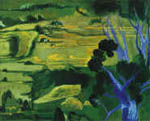
River at Snake Gully - Home of Australia's ill-tempered Tiger Snake
This canvas is the most complex of the artist's early Australian series and uses a wider range of techniques than that of other works completed in the same period. The canvas was primed with a soft burnt umber tinted gesso on which the design was outlined in white. Some fragments of this are still visible in the silhouette of the upper right hand side trees. The painting originated with a pen and ink drawing showing the trees to be located to the left, a wide flowing river in the background, and a grass covered mound appearing at the point where the river widens. On the nearer bank is a rock-strewn area and a small pool from which reeds are growing The original drawing also shows three figures, with shovels and pickaxes, engaged m opal digging.
In the subsequent painting the figures have disappeared and the relatively simple pen drawing is transformed into a canvas of some complexity. The grassy mounds in the centre of the river have now moved centre left of the canvas. Its shape, the rocks protecting above the water and the movement of the river itself are all indicated by a warm mid-green colour The colour continues into the lines of ripples becoming tones of cadmium yellow and mixtures of yellow ochre.
Apart from the lower right quarter of the canvas the rest of the work, including the river and its movements and the various features dominate the canvas in a mixture of greens which run the gamut from very light tones to greens with am orange undertow. The flat green bank on the lower right, dotted with rocks and inlets, extends leftwards assuming shapes which evoke the forms of the artist’s earlier surrealism. In place of the three figures fossicking* stands a eucalyptus tree. This is painted in tints of of deep cobalt, ceruleum blue and white. The darkest tone of the work is the tree's foliage, executed in a deep viridian. The foliage seems to unwind and continue into the dark centre of the and mass. It is repeated in the rocks and the grassy banks in the reminder of the canvas.
*An Australian term, originating in the Cornish gaelic language, meaning prospecting for gold or precious stones.
 Large image, details and buy
Large image, details and buy

Australian Homestead
An early twentieth-century Australian homestead overwhelmed by the encroaching forests of the Victorian Alps.
 Large image, details and buy
Large image, details and buy
.jpg)
Abandoned Timber Homestead in Australian Outback (The Orange Gate)
The paintings the artist was doing at this time were normally the result of pencil sketches done in-situ of different elements which then would be incorporated into the finished composition. The 'Orange Gate' when completed was exhibited in his Sydney exhibition. Subsequently Matthew Moss undertook various changes and revisions to the canvas until it assumed the appearance it has today. The Orange Gate is an abandoned timber homestead in the Australian outback with its corrugated iron roof, its brick-built external chimney and rainwater tank. (Because the abundance of available space in the Australian bush at the juncture of the nineteenth and twentieth century it was more practical for a squatter to walk away from the old home and start to build again something more suitable somewhere else in the vicinity). In the painting the artist shows his interest in the use of the vertical and horizontal lines of the subject to create movement in the composition. The artist was using then a very softly and absorbent priming on his canvas making the application of pigments a difficult feat, but it produced a particular richness in the colours and a wide gamut of tints.
 Large image, details and buy
Large image, details and buy

During the Building of Melbourne's Westgate Bridge
The West Gate Bridge is a fine example of Australian urban architecture. The painting is the earliest surviving canvas from the artist's stay in Australia. The massive engineering construction was visible from his house in South Melbourne and at the time that the painting was executed was still a year away from completion. The painting shows the bridge that Matthew Moss saw from his studio window in south Melbourne during the final stages before the final span was put in place. The construction is an object of very pleasing aesthetic nature with the sea and the landscape emphasizing its grace and form. The sinuous shape of its 2,500 meters constructed in box girder and cables in turn emphasises the beauty of Melbourne's coastal landscape. A few years previously 15 October 1970 the missing span shown in the painting had collapsed during construction falling into the Yarra river below. Thirty five workers lost their lives including a high proportion of Irish navvies employed in its construction.
The centre of the canvas shows some houses sketched in in red, with the Westgate bridge dominating the upper portions of the canvas. The town hall, in light ochre, reds and greens, with its impressive clock tower, does the same for the lower part. The buildings of Port Melbourne, then a working class district on the seafront appear below the pylons of the bridge. Their tin roofs, elaborate chimneys and cast‑iron work façades are characteristic of late Victorian architecture in Australia. The turreted building and silhouettes, seen in front of the bridge, is the town hall of Port Melbourne. During Matthew Moss' residence the area was reminiscent of New Orleans to where a lot of the ironwork of the façades was exported in the late nineteen sixties.
The painting is executed on a roughly woven canvas with a dark umber priming over which, a deep prussian blue has been scumbled. The outline of the bridge's structure was drawn in yellow ochre and a very flat ultramarine blue with the addition of white was used to give form to the structure and at the same time achieve a soft pastel effect. While the background tone and the bridge itself are executed in acrylic, the red roofs of the buildings to the left are scumbled in oil. A number of the roofs in the foreground are in various tones of green which is repeated in the stylised green foliage below the incomplete bridge. The power pole in the lower left appears in the same point of the pen drawing of the subject done some weeks after the artist's arrival. Images of pylons in this canvas , created from rough hewn tree trunks are derived from drawings the artist made later in Heyfield, Victoria state.
 Large image, details and buy
Large image, details and buy

Old Timber Railway Bridge, Heyfield near Walhalla in Victoria
This comparatively large painting was preceded by a fairly complete drawing done at Hayfield in the Gippsland area of the state of Victoria, Australia. It is a small town nestling in the foothills of mountainous country; the logging and the timber milling region for the state. The area, which is lushly vegetated, was settled early on in the history of Australia and claimed a number of goldmining towns in the vicinity of which Walhalla is possibly the most noted. Being a timber region extensive bridgeworks were constructed for the railway line of 1878 in timber and remain in use today.
In the drawing, and the painting which followed it the artist indicates the massiveness of the construction with straight vertical and horizontal fines. These, boldly laid on in contrast to the fight and delicate treatment of the same elements in the, Abandoned Yellow Timber Hay Barn in Gippsland° are inpainted with solid flat areas of mauve, madder, cobalt and ceruleum blue. The road in the foreground and the hill through which it passes are treated in a similar fashion in a gamut of greens which foreshadow in their range the subsequent 'Mount Buffalo waterfall' . In the upper reaches of the painting the luxuriant foliage of the trees are laid in, in firm brushstrokes offering a vertical contrast to the horizontal railbed cutting across the width of the canvas. This painting as are most of his Australian period works is of Belgian linen primed with a semi absorbent chalk medium. Over this is applied an undercoat of raw umber upon which the work was begun laid out with a round brush and dark pigment. The oil sketch was executed and the canvas commenced in tones of yellow ochre. It had not progressed to any noticeable extent when it was laid aside as the artist prepared to return to Europe.
Upon his return to Australia he worked on it again. It underwent changes with more drawing added to the work on the railway bridge. The dimensions of the bridge struts were altered, some new ones added and others eliminated. The colour scheme underwent a complete change, the softer scheme of the earlier stage being now supersceded by a range of contrasting strong colours. The elaborate design of the lower half was sharply simplified and a more calligraphic use made of the paintbrush to indicate the pathway in the lower left and shadows under the pylons. The treatment of the trees in the upper section are now somewhat reminiscent of the work of the Vienna sezession painters particularly Gustav Klimt.
°http://www.artmontecarlo.com/upload/229-Yellow%20Barn%20Australia%20Large.jpg
 Large image, details and buy
Large image, details and buy
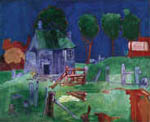
Australian Native Trees (The red trees)
This relatively small canvas is one of an early group of works remaining from the beginning of the artist's sojourn in Australia. He was attracted by the unusual appearance of the Australian landscape, the architecture of the farmhouses, the dominance of trees and bush and the lavish use made of timber in the construction of the man made environment. The painting is on a Belgian linen canvas primed in white over which are washed various light tints which peer through in the final paint layer. The relatively small number of landscapes Matthew Moss painted in Australia before this, concentrate on the buildings and the farms themselves. In this painting the artist confronts the unusually formed and shaped Australian native trees, especially the variations of the native Eucalyptus, for the first time. This interest in the unique forms of Australia's indigenous trees is often noticeable in the work of the early European settler artists in Australia and especially the most notable, John Glover° who moved to Van Diemens land from London in 1831.
Glover's landscapes are often attempts to come to terms with a type of tree which assumes such unusual and contorted forms, so different to those of Europe. Later nineteenth‑century landscapists like the German Hans Heysen tackled the same problem by imposing a European style on the gum trees, in his case, by working in the manner of Pieter Paul Rubens. Matthew Moss, in this canvas, has taken the distorted tree trunks and simplified them, making them stand out against a dark blue sky. The sombre brooding nature of the landscape, enforced by the dark sky and the terra verde tinted landscape, is emphasised by the dark violet of the stone cottage. An early Australian link with Italy is preserved in the bluestone farmhouse of the painting. This part of the canvas is based on the artist's pencil drawing of two abandoned stone farm buildings from the Yandoit region of the state of Victoria. These buildings are all that remain of a Piedmonte colony that settled in the region in the middle of the nineteenth century and imported their distinctive style of stone‑built architecture, The drawing was also the basis for a small painting in which the two farmhouses are described in more detail.
The artist's interest in the way timber was used in fencing, and the sculptural shapes it assumed with use and weathering is visible in the foreground elements. Together with the tree stumps depicted, this theme runs through a number of the artist's subsequent canvases. The abandoned relics of machinery and the timber shed at the bottom right of the canvas are all that remain of more complex elements that were progressively eliminated during the painting's creation. The soft appearance that the surface the canvas displays results from light priming and the use of diluted pigments. The canvas is given its direction and its style by the sharpness of the colour contrasts and the saturated nature of the main tones. This painting formed part of the series of works which the artist exhibited later in Melbourne and Sydney.
°John Glover exhibited at The Royal Academy in London from 1799 onwards. In this period he was considered an artist superior to J.M.W.Turner
 Large image, details and buy
Large image, details and buy

A cottage in Australia
The elaborate architectural form of the corrugated iron-roofed building from which sprout the red-brick chimneys is framed by trees of dark green .
 Large image, details and buy
Large image, details and buy

The Lean-to Barn
A typical temporary iron-sheeting structure used in Australia's Victoria State to shelter hay and cattle.
 Large image, details and buy
Large image, details and buy
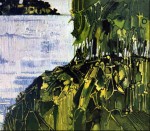
Mangrove Swamp on Queensland's Great Barrier Reef
During his stay in Australia Matthew Moss visited the tropical rain-forests on Queensland's Great Barrier Reef. The journey by train from Melbourne to Brisbane and northward to Tully, reputed to be the second wettest town in the world was long and tiresome. Some 52 kilometres north of Tully the artist alighted at Innisfail a small town considered to be the second wettest town in Australia. Here Matthew camped out in the bush at Mission Beach for three months and produced, amongst other canvases, 'Mangrove Swamp on Queensland's Great Barrier Reef''. The manner in which the artist has reduced the mangrove foliage to iconic shapes show the artist's indebtedness to the Chilean-born Surrealist Roberto Matta. The mangrove trees and the leaves and vines are indicated by sometimes borrowing the symbols he used in the mid 1960s Roman paintings. Despite Innisfail's tropical climate and reputation of being humid, warm and always raining the artist found it an ideal climate for working outdoors. The tropical rains fell, usually, only at night making the working day fresh and most pleasant.
The green and yellow vegetation mass on the shore frame against the vast Coral sea. Dunk island is seen in the background. On occasions, as the artist painted outdoors the only sign of movement would be the great white-headed Sea eagles Stuka-diving the surface of the sea and lifting off again with, held in his beak, a large fish to deposit on a nearby rock. A number of artists worked and lived in the bush in Innisfail in an Arcadian tropical ambient that would have aroused the envy of Paul Gauguin. The humid warm weather was, however, a serious disadvantages for painters whose paintings, both the canvas and the paint layer, were constantly attacked by mould causing them to decay rapidly if the artist did not ship the finished work out of the region quickly.
 Large image, details and buy
Large image, details and buy

Ancient Boardwalk at South Melbourne Beach
The artist's interest in the architectural use of timber and the artistic effects achieved by weathering is seen in this acrylic painting based on drawings done in the bayside area of Melbourne. It is a popular recreation area where the piers, running into the sea, gradually become more deteriorated as one moves closer to the harbour of Port Melbourne nearby. The artist executed a number of drawings of these piers in various stages of decomposition. In the scheme of the painting a flat blue tint was laid onto the white primed canvas, the design commencing with the simplest indication of a pier in the far background merging into the fine of the horizon. The presence of the sea is indicated by a slight wash of a deeper tone brushed in below the timber structure. The centre of the canvas is taken up with fragments of an old pier where little more than the stumps and some planks remain. Although at this point it is still sketchily indicated, the cobalt blue used is denser and flat areas of colour make an appearance. It is joined to a pier which is more elaborately executed by Matthew Moss painting shadows in the sea.
This platform, in light and dark greens cutting across the canvas in the lower centre, leads the eye to the foreground where waves break onto an ochre coloured beach containing a foreground pier in strong reds. The eye is drawn downwards, from the simple fines at the top to the stronger colours and more complex design of the centre of interest in the lower part of the canvas. The overall blue of the background provides a neutral setting against which are set off the shapes of the old and worn timber structures.
 Large image, details and buy
Large image, details and buy
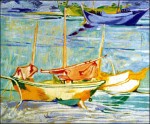
Medieval Felucca Sailing Boats at Djibouti on the Red Sea Coast
Matthew Moss was asked by the Australian government to advise it on setting up a conservation laboratory for the restoration of Australian Old Master paintings in the historic township of Ballaret in the state of Victoria near to Melbourne. He sailed for Australia from Genoa on the Italian liner the Galileo Galilei. 'Boats at Djibouti' was painted by the artist while travelling eastwards through the recently re‑opened Suez canal. The long flat dhows had been used from medieval times to transport cargo along the Red Sea coast.
On the artist's journey the packet boat made a stop at the then French colony, Djibouti, resulting in two signed drawings of local boats. One of the pencil drawings is a series of four studies of feluccas that appear in a painting completed as the journey continued through the Indian ocean. Above the upper horizon to the left of the painting appear clouds taken from drawings done from the wake of the ship as it proceeded through the Red Sea. The fine grain Irish linen canvas had been prepared prior to the journey in Italy with a light ochre tone which appears through the azure sea background. The boats are similarly delicately executed, the technique ensuring that the two at the top merge gradually with the background tints and shapes.
The first drawing is also the source of the background boat appearing in the lower half of the canvas. It is of an intense cadmium yellow and the form is defined with flat white panels. The effect creates a two dimensional shape which does not unduly arrest the eve but instead leads it towards the foreground boat. The eye is further nudged in the same direction by the shape and direction of the ripples in the sea moving upwards from the base of the canvas. These are delicate traceries of white, fight cobalt and azure with some touches of emphasis created by the line of blue beneath the boat, the small shape of the rowing boat and the deep blue green shadows beneath the background one. The foreground subject attracts the eye by the greater amount of colour in the hull: orange, white, yellow and green. This is further reinforced by the light cadmium yellow of the sails which is continued on in to the orange of the masts. The foreground boat is based on a second drawing done at Djibouti of a solitary felucca and similarly dated. The painting was completed and exhibited on board the Galileo Galilei prior to its arrival in New Zealand along with a work of the same format completed on the voyage and a group of Italian canvases.
 Large image, details and buy
Large image, details and buy

Tropical Rainforest and mangrove swamps at Mission Beach, Queensland
The artist travelled to the wild, tropical rain forests of the far north of Queensland on Australia's north east coast. He ended up living and painting for three months in the then wild and largely uninhabited Mission Beach on the Coral Sea.. Two of the three paintings done at this time in the rainforest were The Papaw Trees and the present work Rainforest at Mission Beach. Matthew Moss produced three canvases in this time, as well as numerous gouaches and pencil drawings that later he employed as the basis of further tropical rainforest paintings when he returned to Melbourne.
This painting done on the site does not do credit to the venomous local wildlife, bush flies, soldier ants and snakes that made painting it both difficult and hazardous. A drawing of a massive climbing vine which he completed on the tropical Dunk Island nearby was incorporated on his return to Melbourne into the Mount Buffalo Waterfall, where it it is seen climbing the supports of the timber bridge. From this visit the artist developed a concern with the language of landscape painting as distinct from any buildings that it might contain.
 Large image, details and buy
Large image, details and buy

The Paw Paw Trees
This is the largest of three canvases Matthew Moss carried out in the tropical rainforests of northeastern Australia. The other two canvases depicting an area of mangrove swamp, were brought to a lesser state of completion because of the physical conditions involved in working out of doors in a jungle area. The latter two were finished in the studio, using gouache and pencil drawings done on the site.This canvas was painted close to the mangrove swamps, in the lush tropical gardens of a house built on stilts and constucted of corrugated iron, belonging to a prawn fisherman.
Apart from modifications to the design of the roof and the water tank beneath, the work remains essentially the same as worked on in-situ. What principally attracted the artist was this magic area's abundance and variety of trees that range from the dying palm on the left to the banana plants on the right. They sail into the air and form a baroque frame to the sky, with the dark shadows of the jungle reaching down to the rear of the house and forming a backdrop.The central feature of the painting is the group of three papaya or papaw trees set to the left of centre canvas, which sweep to the top of the roof and reveal a fourth beyond. At the base of the trees are scattered fallen ripened orange coloured fruit which lead right of centre to the dying foliage of the lower parts of the fruit laden banana tree.
The theme of the papaw trees is repeated in the dark background sketchily indicated in dark green. The leaves of the palm trees to the left are suggested by feathery brush strokes and continued by the foliage of the papaw trees to complete the circle enclosing the fisherman's house. This painting by Matthew Moss, in oil on white primed canvas, is fairly representational of his Australian tropical rainforests period. The multiplicity of forms represented by the different trees permitted the artist to create a pattern of shapes and lines giving a sense of movement that put into contrast and frame the form of the tin-built hut.
 Large image, details and buy
Large image, details and buy
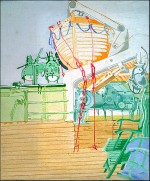
The Deck of the Soviet Packet Boat, M.V. Taras Shevchenko
View from the deck of a typical packet-boat, the M.V. Taras Shevchenko, that journeyed between Europe and Australia until recent times. This was one of the last Soviet Union ship to do the Europe to Australia run. Moss painted the acrylic on canvas on board ship during the journey from Southampton, England to Melbourne, Australia. A number of preliminary drawings were done on board including works in pen and ink. Another drawing that survives and was used in the composition is a pencil drawing Matthew completed while crossing the Indian Ocean at about the same period to Singapore in the MV Kata Singapura. It contains a number of elements used in the final canvas including life-boat details. Even in those days, the seas off Indonesia were pirate-infested. As the vessel passed through the Coral sea Matthew Moss created the work of art under the curious gaze of heavily armed soviet sailors who were moving constantly about the decks and watching for any unusual movement from other ships in the proximity.
The teak timber deckchairs that take up the right foreground are typical of the period when travelling long distances by ship was an option to airlines. Deck furniture was basic without the comforts and the over indulgence of cruise ships which supplanted their disappearance as the various petrol crises of the last quarter of the twentieth century reduced the economic importance of this type of packet boat. The predominant colours of the canvas are cobalt blue and a variation of viridian green, used to represent the deck furniture and the metal structure of the deck including the flood lamps and dividing walls and rails, not forgetting the flat blue area indicating the sky. There is a transition to cadmium and ochre yellow in the timber deck and the outline of the life boat. To add plasticity to the objects depicted and a shot of warmth to the overall composition Matthew adds a touch of cadmium red to the steel chains bolted in to the deck in the centre, holding the life boat in place.
 Large image, details and buy
Large image, details and buy

Corrugated-Iron Barn with Tin Roof in Gippsland, Australia
The Dark Barn, is a painting which comes into the period of The Yellow Barn and, Railway Bridge at Heyfield. It differs in one way in that it derives from various pencil drawings done at Heyfield, in the state of Victoria and later transferred to canvas. The basic design comes from a drawing of a hay barn with its tin roof and corrugated iron walls falling apart and exposing the timber structure and the bales of hay beneath. The work is formally set to centre of the canvas in a symmetrical design against a plain blue sky relieved by a green tree and some foliage. The second design used was a very detailed pencil drawing showing a Pre‑Raphaelite attention to detail. It was of some flowering shrubs which appear in the right foreground and left of centre.
The dark appearance of the canvas gives it a seventeenth century Dutch feeling due to the use of various combinations of brown earths, ochres, and the dominance of a dark umber tint which appears as the base colour in the tin roof. The painting was planned with a deep tonal quality by priming the Belgian linen canvas support with a white acrylic preparation followed by undercoats of dark acrylic tints. In the upper area containing the sky the blue acrylic tint was laid on in a thin wash to allow the undercoat to appear. The roof was left as an unretouched undercoat overlaid with the details lightly applied. The remainder of the painting was carried out in oils. Matthew Moss modified the painting two years after its completion by adding further elements to the design. The artist inscribed the canvas, base right, with his signature, where it was created and the date.
 Large image, details and buy
Large image, details and buy
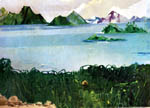

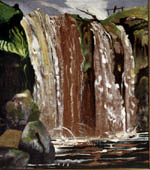
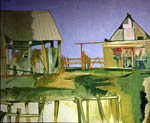
.jpg)
